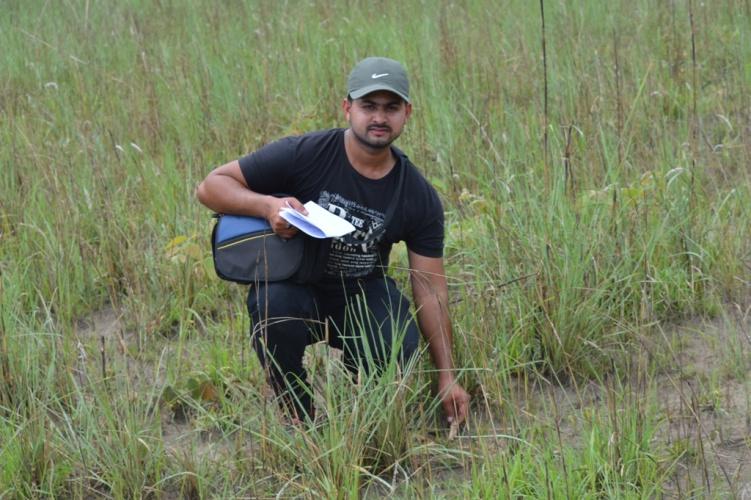Dipendra Joshi
Conservation of critically endangered hispid hare has limited in Nepal, where its habitat is severely under threat and population is critically declining. There are still many areas that have not been surveyed. Hispid hare has been reported from grass land ecosystem of Suklaphata National Park (SNP). The grassland habitat of hispid hare is vastly threatening due to overgrazing of livestock and other anthropogenic disturbances in SNP. The proposed study aims to initiates the sustainable conservation program for hispid hare in SNP. This project conducts awareness program, distributes outreach materials and assess the habitat and species status of hispid hare.

PI in the field. ©Rashmi Chhetri.
The hispid hare is one of the globally critically endangered small mammals by IUCN red list. The world population of hispid hare is approximately 300 individuals throughout its distribution range scattered over fragmented landscapes (Aryal and Yadav 2010). Historically the species was distributed throughout the southern lowland of Nepal to Uttar Pradesh, west Bengal to Assam of India; however the present distribution range is not known (Jordan et al. 2005). So the conservation of this species in the wild is especially challenging particularly from the perspective of viable population and anthropogenic activities. In the present day, Hispid Hare is known to exist only in a few isolated pockets across the formal range of its tall grassland habitats in India and Nepal. The proposed project aims to raise community awareness about Hispid hare conservation.
The study sites, Suklaphanta National Park (SNP) lies in the far Western Nepal in Kanchanpur district of Nepal. The area is composed of forest (65.02%), abandoned agriculture land (7.87%), grassland (16.1%), shrub land (3.76%) and water bodies (7.25%) (DNPWC 2006). Habitat types are forests, grasslands and wetlands (Sah 2002). It contains more than 665 plant species belonging to 438 genera and 118 families. Forty-three species of mammals including rhino, tiger, common leopard, Asian elephant, swamp deer, and hispid hare (Oliver 1985, Yadav 2006), and 349 species of birds are found in the Park.
The Hispid hare is mainly threatened by habitat destruction for agriculture, forestry, human settlement, and overgrazing (Aryal and Yadav 2010). Overgrazing, continuous grassland burning and invasion by woody perennials in grassland patches in the SNP are possibly major threats for the survival of Hispid hare in SNP. So, our work will be focusing to conserve the potential habitat of the Hispid hare in the SNP. Community outreach materials will be distributed to the community forest staffs, the forest users group, local peoples and local “eco-clubs” members. Moreover, our objectives are to explore the population estimation, habitat threats, prepare the distribution pattern of the Hispid hare in SNP. Community awareness program will be conducted to promote the conservation knowledge of local people about the Hispid hare. Community stewardship will be initiated for the sustainable conservation and monitoring of this critically endangered fauna in Suklaphata National Park (SNP) and its Buffer zone.